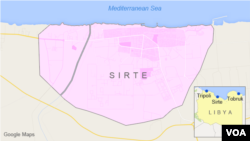Libyan TV reported is reporting that Islamic State (IS) militants killed several dozen captives Friday in the Libyan port city of Sirte.
IS carried out the killings before dawn, shortly after regaining the Sector 3 district of Sirte, which had been take by a rival group of Salafist rebels earlier this week.
More than 50 other people also were reported killed in four days of fighting.
Ibrahim al-Mleitan, a member of the Sirte city council, told Libyan TV that witnesses claim to have seen dozens of captives killed by the IS militants following Friday prayers. Witness say a vehicle brought the captives to the courtyard of the Cordoba Mosque, where some 50 or 60 people may have been put to death.
Unity among rivals
Members of Libya's two rival governments protested IS's brutal tactics. Acting Prime Minister Abdallah al-Thini, who leads the interim government in Tobruk, condemned the bloodshed in Sirte and appealed to Western nations to intervene.
The military commander of the Islamist-supported government in Tripoli, Abdel Salam Jadallah Obeidi, insisted that his forces would continue battling IS aggression with all its might, and urged the outside world to help in the fight, as well.
Al-Arabiya TV reported that Libyan warplanes loyal to the government in Tobruk and army commander Khalifa Hafter bombed IS positions in Sirte several times since fighting began early in the week. The television network also reported that the rival Islamic Dawn coalition in Tripoli was recruiting young men to fight in Sirte.
Anas el-Gomati of Libya's Sadeq Institute research organization told VOA that IS recruits supporters from those who have been ignored or neglected by the two larger factions in Libya.
“ISIS is working a very neglected terrain," said Gomati, using a different acronym for IS, which is also known as ISIL. "It works alongside roads. It works in cities where neither side has a desire to go and govern. So, ISIS makes its gains and finds its power in the weakness of its opponents.”
Gomati stressed that quarrels between rival militias, including IS, have “regional, as well as local dimensions.”
IS, he argues, grows by dividing communities and seeking support from those who have been “marginalized” by larger militias. He added that it thrives in “that very nasty terrain created by war.”










